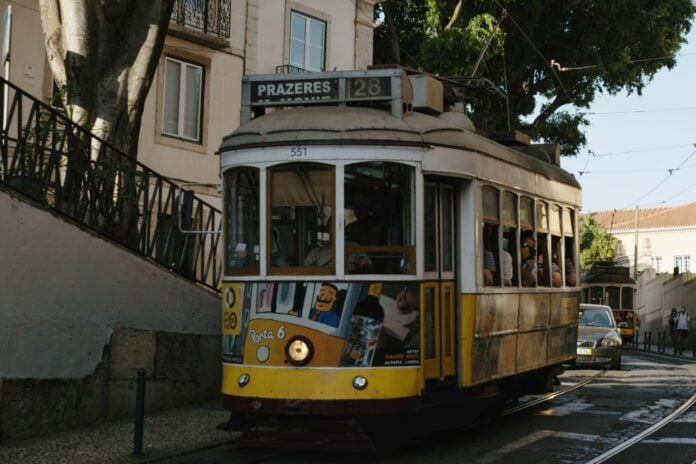Planning a trip to Lisbon? I bet you’re looking forward to riding (or at least seeing!) the famous Tram 28, right? But what is it about this tram that made it so popular among tourists?
Riding Tram 28 in Lisbon can truly feel like you have stepped back in time. The trams have kept their vintage look. And now they’re taking you on a whirlwind tour of the city’s most Instagram-worthy spots! Riding Tram 28 is also the perfect way to begin your journey through Lisbon – keep your Google Maps open along the way and mark the spots you’ll want to visit on foot!
Keep reading to discover more about the history of Tram 28, details about some of the most famous places you’ll pass by, as well as about the Tram schedule and prices.
Tram 28, Lisbon – A Bit of History
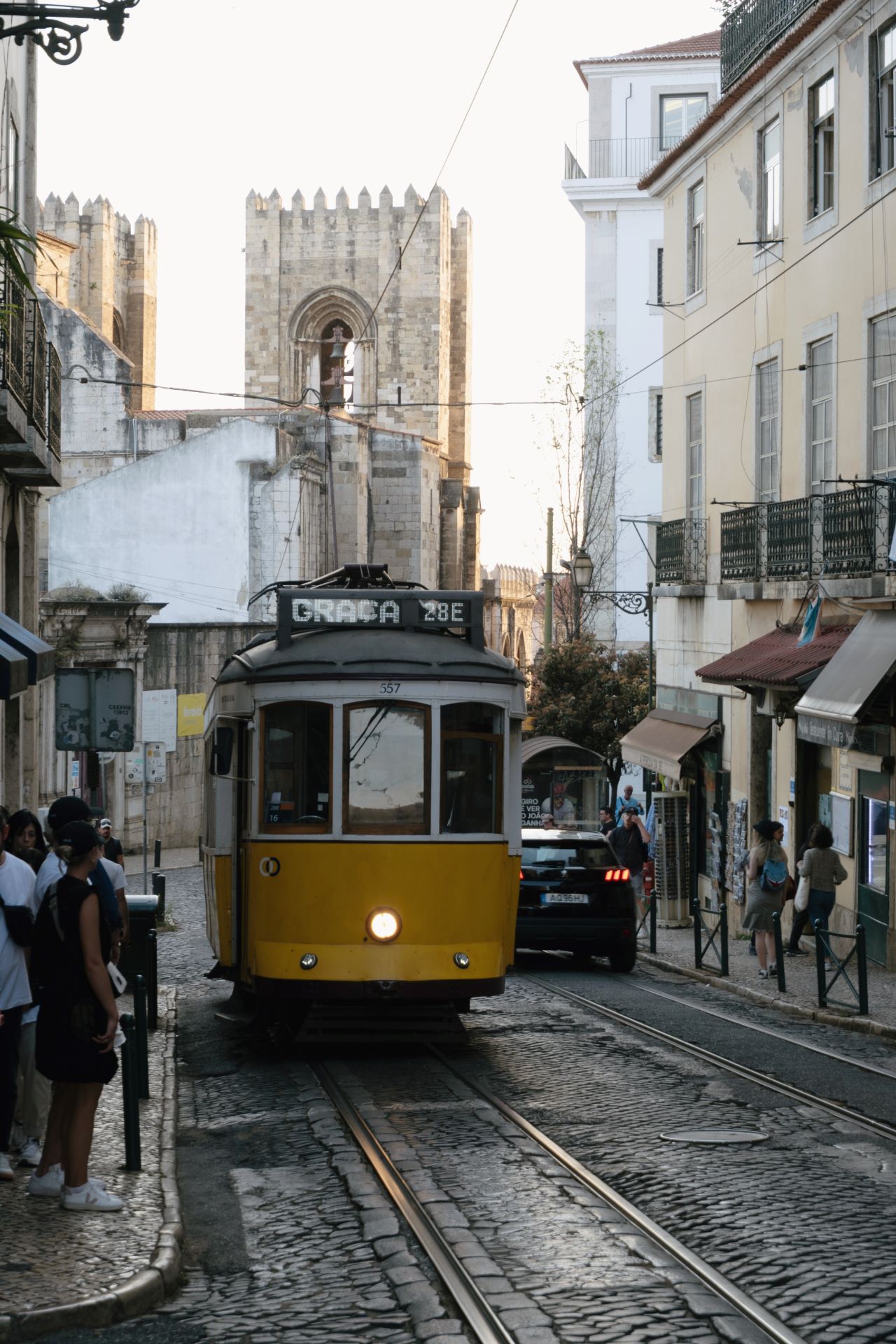
Today, the Tram 28 route connects Martim Moniz with Campo Ourique. It passes through popular areas like Alfama, Chiado, and Estrela. However, a century ago, this tram had a different route. It connected Praça Camões and Estrela.
Tram 28 was inaugurated in 1914. Its inauguration was part of Lisbon’s efforts to modernize its public transportation system. Initially, the tram service replaced horse-drawn carriages – the primary means of transport in the city at the time. The first electric trams were actually introduced in 1901. But it wasn’t until 1914 that Tram 28 began its service.
When I first took this tram, I was expecting it to be filled only with tourists since it has become famous among tourists worldwide. In fact, I once used to think Tram 28 was only a tourist attraction and locals preferred to avoid it because of how crowded it got. I’ve since discovered that locals also use it to get from one neighborhood to another, which makes the trip feel much more authentic!
Tram 28 – Evolution and Preservation
Tram 28 has survived the rise of automobiles and buses. It excels at navigating the narrow streets of Lisbon, so why would anyone want to get rid of it?! Some streets are actually so narrow that you can touch building walls if you reach out to them from the tram (don’t try it though!).
The trams used today are vintage models from the 1930s. Their wooden interior is truly incredible. And, of course, the classic yellow exterior is a timeless design! Thanks to the efforts to preserve its original appearance, Tram 28 is now one of the biggest tourist attractions in Lisbon – can you imagine that it transports around 4.5 million passengers annually? Not to mention that it’s now featured on postcards, souvenirs, azulejo tiles, tote bags, and whatnot.
Tram 28 – Schedule and Tickets
Trams run daily as follows:
- The first tram starts from Martim Moniz at 5:40 am; the last tram starts from Martim Moniz at 11:30 pm
- The first tram starts from Campo de Ourique at 6:30 am; the last tram starts from Campo de Ourique at 23:52.
Frequency is every 10-15 minutes on average. However, this is the schedule for weekdays – on weekends, the schedule is more limited, so make sure to check it here.
One ticket costs 3 EUR if bought on board, or you can use a 24-hour transit pass for 6.80 EUR.
Tram 28, Lisbon – Route and Stops
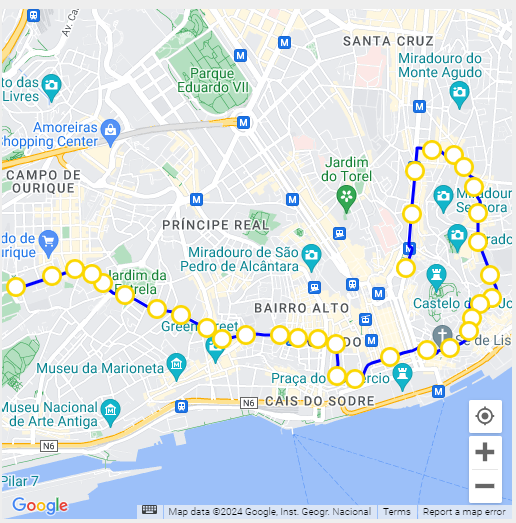
As mentioned, Tram 28 connects Martim Moniz with Campo de Ourique. It has a 7-kilometer route and over 30 stops. Keep reading to discover bits of history about some of the most notable locations you’ll pass by while on Tram 28!
Martim Moniz
The Martim Moniz statue in Lisbon commemorates the heroic act of Martim Moniz – he was a Portuguese knight who sacrificed himself during the Siege of Lisbon in 1147 to help King Afonso Henriques take the city from the Moors. The word goes that Moniz lodged his body in the closing gates of São Jorge Castle. This allowed his fellow soldiers to secure the door and capture the castle. He was killed in the incident.
Igreja de São Vicente de Fora
The Igreja de São Vicente de Fora in Lisbon. The original structure was built in 1147 in honor of Saint Vincent of Saragossa, the city’s patron saint. However, the current Mannerist structure was built a few centuries later – between 1582 and 1629. It has a stunning Baroque altar and a richly decorated interior with over 100,000 azulejos!
Alfama District
The Alfama district is Lisbon’s oldest neighborhood. Every time I walk the narrow streets of Alfama, I’m amazed at how culturally and historically rich they are! Having survived the 1755 earthquake, Alfama now has a unique charm accented by whitewashed centuries-old buildings, vibrant local life, and stunning views of the Tagus River.
Sé Cathedral
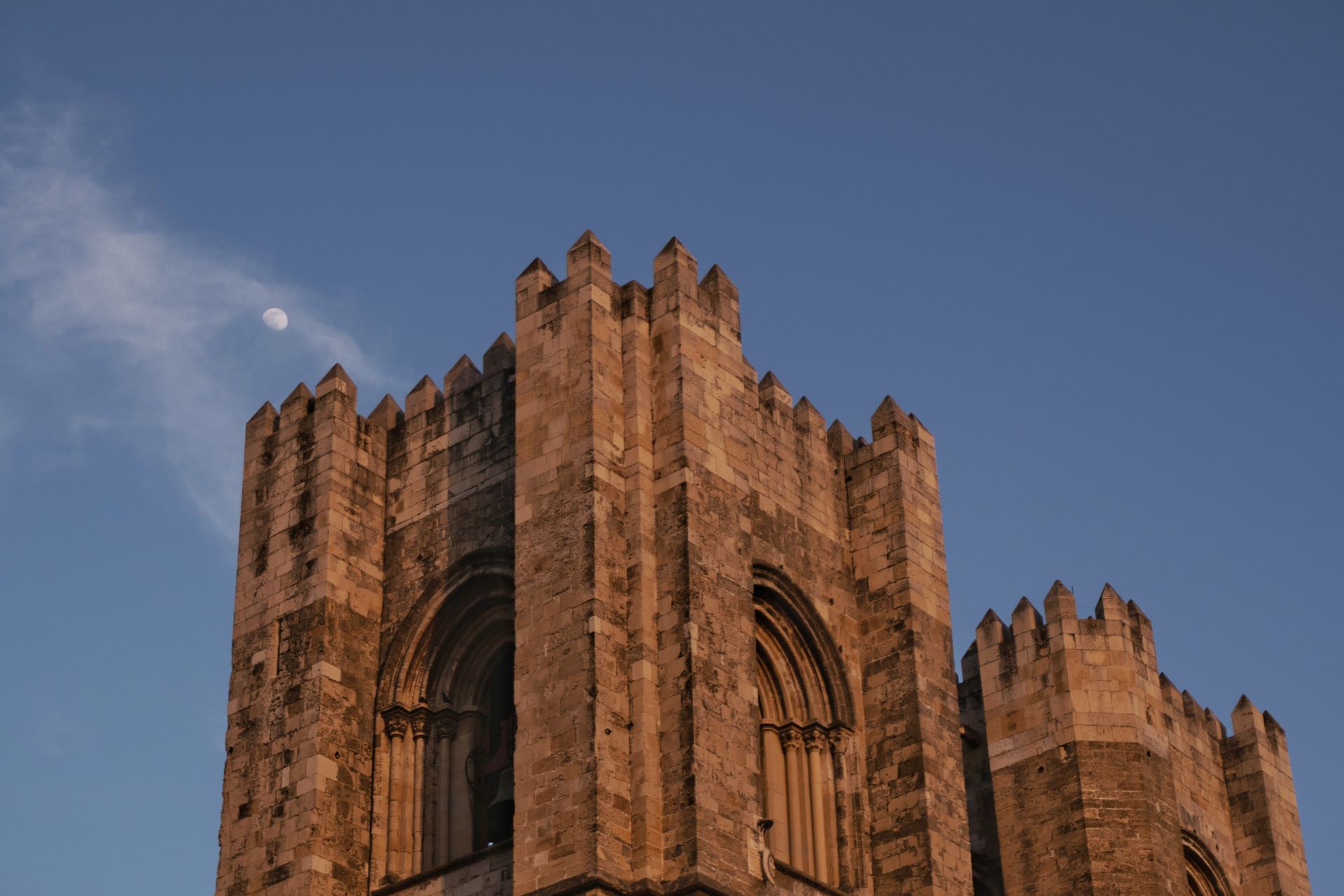
Sé Cathedral, or Lisbon Cathedral, is the oldest church in Lisbon. It was built in 1147 on the site of a former mosque. Its architecture has Romanesque, Gothic, and Baroque elements. The cathedral survived the 1755 earthquake that devastated much of the city, although parts of it, such as the Gothic main chapel, were almost completely destroyed. The cathedral’s impressive rose window, reconstructed from original fragments, only adds to its architectural charm!
Arco da Rua Augusta
Although Tram 28 doesn’t pass directly by the Arco da Rua Augusta, you’ll still see it from afar. The arch was completed in 1873 and symbolizes the city’s recovery from the devastating 1755 earthquake. Its grand design features six towering columns and statues of notable historical figures, including Vasco da Gama and the Marquis of Pombal. In short – it is truly a must-see structure in Lisbon! But don’t worry – you’ll have plenty of time to see it up close it while exploring the city on foot, as it’s right in the heart of the Lisbon center!
Chiado
The Chiado district in Lisbon is a vibrant blend of history and modernity – it’s known for its elegant shops, theaters, and cafés. In other words, it’s the destination for culture enthusiasts who want to learn more about the writers and musicians who shaped Portugal. In fact, it is now quite famous thanks to Fernando Pessoa’s statue (which you’ll see from the tram) and the historic A Brasileira café. Get ready to mark it on your map because you’ll certainly want to return there!
Estrela Basilica
The Estrela Basilica in Lisbon has a gorgeous exterior you’ll get a front row seat to from Tram 28! It was built by the order of Queen Maria I as the fulfillment of a vow. The structure features a stunning blend of Baroque and Neoclassical architecture – similar to the famous Mafra National Palace. If you decide to visit it, the interior will truly amaze you! It features intricate marble patterns and artworks signed by renowned artists, as well as the queen’s tomb. You can also go to the roof and get another view of the inside of the church – an incredible sight indeed!
Tips for Riding Tram 28 in Lisbon
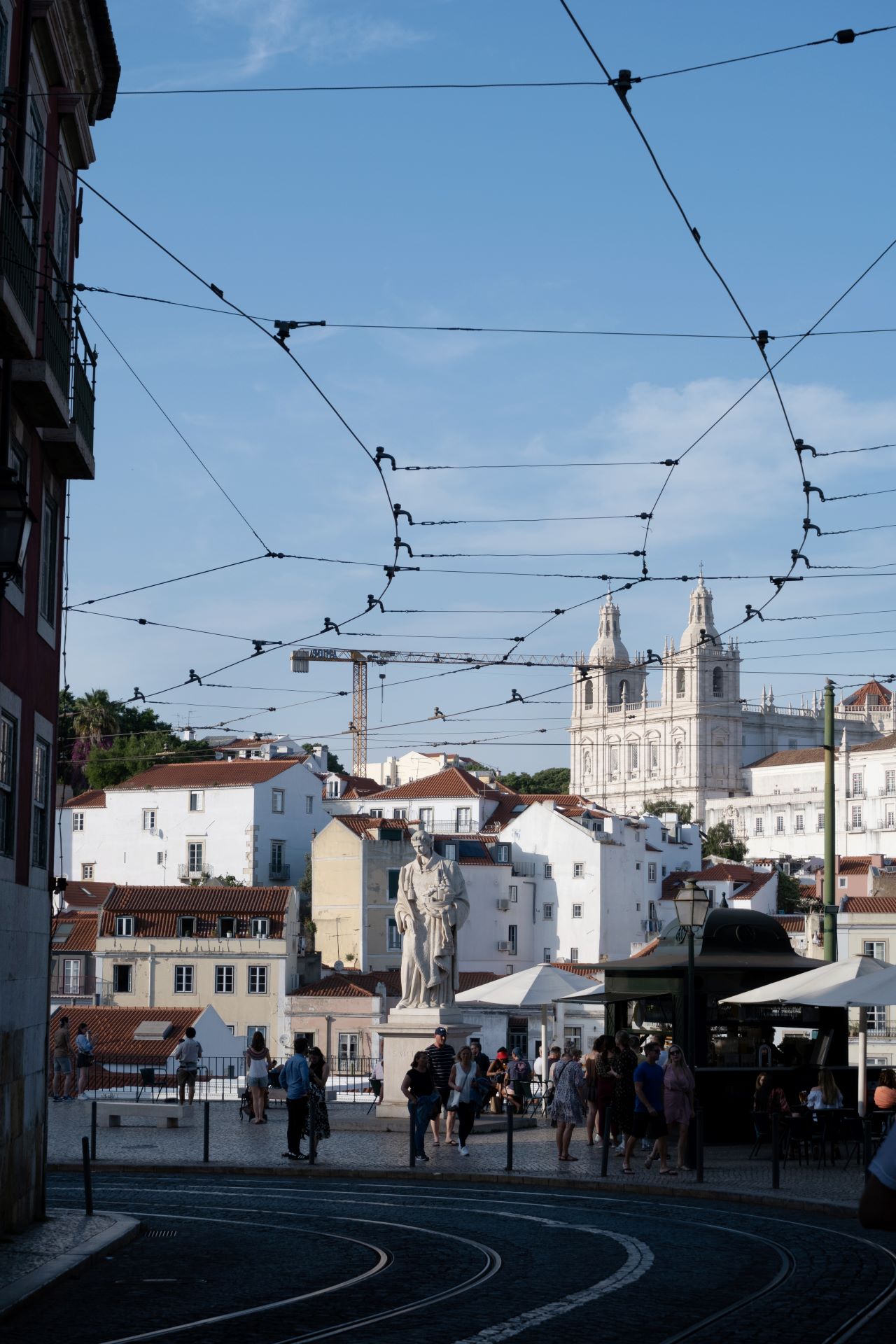
If you don’t like crowds, arrive early in the morning (6-8:00 am) or late at night (9-11:30 pm). However, if you can’t make it in the morning or evening, just board the tram at Martim Moniz or Campo de Ourique. It is usually quite empty there, so you’ll definitely get a seat. Considering that the whole route takes 60 minutes, it’s certainly better to be seated – otherwise, you won’t even see much through the windows.
Furthermore, don’t forget about pickpockets – Tram 28 is a popular destination for them.
Frequently Asked Questions
How Do You Pay for Tram 28 in Lisbon?
You can pay for Tram 28 in Lisbon right on the tram. The ticket costs 3 EUR, and you can only use cash. If you have a prepaid transport card, you’ll pay half – 1.5 EUR. You can also use the 24-hour pass if you have one.
Is Tram 28 Worth It in Lisbon?
Riding Tram 28 in Lisbon is definitely worth it! It will take you to the most beautiful places in Lisbon that are filled with culture and history! Besides, it’s an excellent way to find some spots you may want to visit later on foot.
Which Side Is Best to Sit on Tram 28?
You can sit on both sides on Tram 28, as there are plenty of things to see. However, if you can choose a seat, pick the left side if you’re starting at Martim Moniz and the right side if you’re starting at Campo de Ourique.
What Is the Alternative to Tram 28 in Lisbon?
As an alternative to Tram 28 in Lisbon, you can take Trams 12, 18, 24, and 25.
Is Tram 28 the Same as 28E in Lisbon?
Yes, Tram 28 is the same as 28E in Lisbon.

